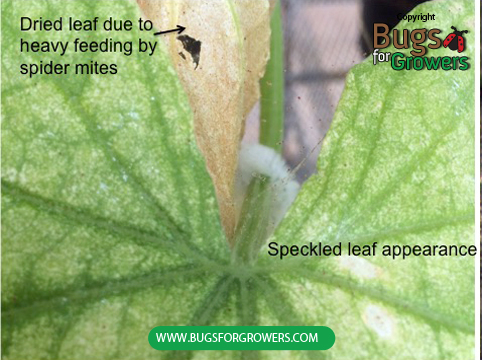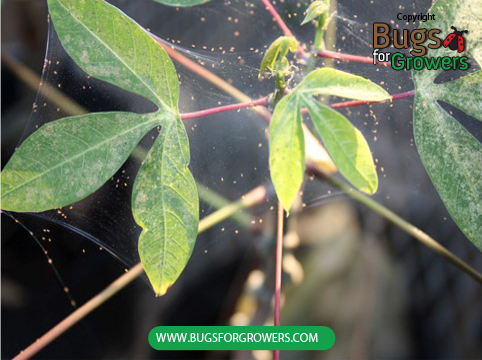Spider Mites are commonly called as Red spider mite, Spider mites or two spotted spider mites (Tetranychus urticae)
Damage caused by spider mites
Spider mites feed on the leaves and flowers of many field, fruit and vegetable crops, and ornamental plants. Spider mites feed by sucking cell sap (juice) from leaves and succulent twigs. The symptoms of feeding damage caused by spider mites include mottled and speckled appearances of leaves (Photo 1), yellowing and eventually drying of leaves and twigs. While feeding, both adults and nymphs of spider mites also produce webbing (Photo 2) that reduces aesthetic value of many ornamental plants. Speckling of leaves also affects the process of photosynthesis in which plants make their own food by using sunlight energy to produce glucose from carbon dioxide and water. The most common host plants include bean, canola, cotton, citrus, cucumber, eggplant, melon, peanut, pepper, strawberries, potato, soybean, tomato, azalea, camellia, hollies, ligustrum, roses and viburnum.
Photo 1. Speckled leaf appearance caused due to feeding by spider mites
Photo 2. Webbing arround leaves and twigs is caused by spider mite infestation (See small brown dots in the web are different stages of spider mites).
Identification of spider mites
Adult mites are about 1/20 inch long, oval shaped with four pairs of legs and two red spots. Depending upon the species, spider mites can be brown, green, red or yellow in color. Adults lay eggs that are translucent and spherical in shape. In the life cycle, spider mites generally have both larval and nymphal stages but not pupal stages. The larvae stages resemble to their parents but they are comparatively small with only three pairs of legs. Unlike larval stages, nymphs are larger than larval stages and smaller than adult stages and develop through two nymphal stages; the first stage is called protonymph and second stage is called deutonymph. Both these stages are with four pairs of legs.
Life Cycle of spider mites
Life cycle of spider mites consist of four stages such as eggs, larvae, nymphs and adults. The spider mites generally overwinter as mated females under the tree bark and/or in previous crop debris. Early in the spring, mated females generally lay hundreds of eggs on the leaves of host plants. Eggs hatch within 2-3 days into small larvae that molt into first nymphal stage called protonymph within 2 days. Then they molt into second nymphal stage called deutonymph within 1-3 days. The deutonymphs then molt into adult stages within 2 day. Under favorable conditions, spider mites can complete their life cycle within 5- 20 days.
Biological control of spider mites
Biological control of spider mites can be achieved by using the predatory insects including green lacewing, ladybugs, minute pirate bugs and gall midges, and predatory mites including Amblyseius andersoni can directly feed on spider mites and reduce their population below their economic damage level. Please click on each predatory insect and mites for detailed information on their rate and timing of of application for the effective control spider mites in your greenhouse and gardens.

